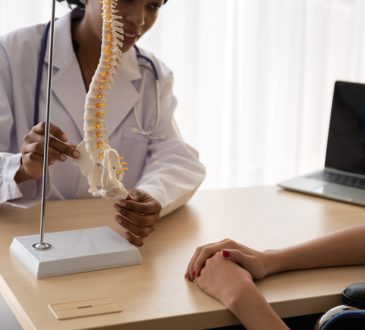
For years, spinal deformity surgery focused largely on straightening curves visible on X-rays. While this approach improved cosmetic appearance, many patients still struggled with pain, fatigue and loss of function after surgery. Today, surgeons recognize that long-term outcomes depend on restoring global spinal balance, rather than simply correcting curves. Dr. Larry Davidson, a board-certified neurosurgeon, with fellowship training in complex spinal surgery, has been a leading advocate for this shift, emphasizing that balance across the entire spine and body is essential to durable, patient-centered results.
This broader perspective has led to the integration of advanced assessment tools, including 3D modeling and motion analysis, which help surgeons evaluate how spinal alignment affects the entire musculoskeletal system. By focusing on balance in both standing posture and dynamic movement, treatment strategies now aim to reduce pain, improve endurance and enhance overall quality of life. This development reflects a more holistic understanding of success in spinal deformity care, one that prioritizes function and well-being, alongside anatomical correction.
Defining Global Spinal Balance
Global spinal balance refers to the overall alignment of the spine in relation to the head, pelvis and lower limbs. A patient with proper balance can stand upright with minimal effort, distribute weight evenly, and maintain comfort throughout daily activities. In contrast, curve correction alone may straighten sections of the spine, without considering how changes affect the whole body. It can result in compensatory imbalances, where one part of the spine or pelvis bears more stress, leading to pain or new deformities over time. Balance coordinates the entire musculoskeletal system, allowing surgical corrections to support both posture and overall function.
Dr. Larry Davidson explains, “The goal is not just to straighten the spine, but to restore balance so patients can stand tall, move comfortably and live fully.” This perspective reflects the shift in spinal surgery from focusing on radiographic appearance, to achieving outcomes that improve the patient’s overall quality of life.
The Limits of Curve Correction
Traditional scoliosis and kyphosis surgeries were often judged by how straight the spine appeared on imaging studies. While these results were visually impressive, patients sometimes experienced stiffness, chronic discomfort or functional decline. Straightening a curve, without considering balance, could shift the body’s center of gravity, forcing patients to compensate with awkward posture or altered gait. It could strain muscles, accelerate degeneration or undermine the benefits of surgery. Cosmetic outcomes alone are not enough. The true measure of success is whether patients regain mobility, independence and comfort after surgery.
Sagittal Balance and Long-Term Health
Sagittal alignment, the spine’s front-to-back curvature, plays a particularly important role in global spinal balance. When sagittal balance is off, patients may lean forward or backward, placing constant strain on muscles and joints.
Research shows that poor sagittal balance is linked to worse pain, reduced quality of life and contribute to higher rates of surgical revision. Correcting sagittal alignment has therefore become a key goal in modern deformity surgery. Focusing on sagittal balance helps patients stand upright with less effort, reducing fatigue and supporting long-term spinal health.
Tools and Techniques for Restoring Balance
Restoring global balance requires precise planning and execution. Advanced imaging, 3D modeling and surgical simulation allow surgeons to map out how corrections in one area of the spine affect overall posture. Intraoperative navigation provides real-time guidance for implant placement, while rods and screws are contoured to support natural spinal curves.
In some cases, osteotomies, surgical cuts in bone, are used to realign severely imbalanced spines. Incorporating these techniques into practice allows corrections to be both structurally sound and in harmony with the body’s natural balance. This approach demonstrates how technology and expertise work together to achieve lasting results.
Benefits for Patients
The focus on global spinal balance offers clear benefits for patients. Those who achieve balanced corrections report less pain, better mobility and improved endurance. They are also less likely to require revision surgeries, as balanced spines place less stress on hardware and adjacent segments.
For patients, this means greater confidence in their recovery and long-term independence. The shift from curve correction to balance-centered surgery reflects a deeper understanding of what truly matters to those living with spinal deformities. Patients with restored balance enjoy more meaningful improvements in daily life, compared to those treated with curve-focused strategies alone.
Rehabilitation After Balance-Centered Surgery
Surgery is only one part of restoring global spinal balance. Rehabilitation plays a vital role in helping patients adapt to their corrected posture. Physical therapy strengthens muscles that support alignment, while occupational therapy trains patients to move efficiently in daily life.
Patients who undergo balance-focused corrections often progress more smoothly through rehabilitation. By supporting natural posture, surgery reduces fatigue and allows therapy to build on a stable foundation. Rehabilitation is most effective when paired with balanced corrections, as patients are more motivated and capable of achieving their goals.
Education and Training for Surgeons
The emphasis on global spinal balance has reshaped surgical education. Surgeons must now learn to evaluate full-body alignment, not just localized curves. Training includes the use of advanced imaging, biomechanical principles and outcome-focused planning.
Dr. Larry Davidson’s commitment to education includes mentoring younger surgeons on the importance of balance in deformity correction. He emphasizes that lasting success comes from combining technical precision with a deep understanding of whole-body alignment.
Patients as Partners in Balance-Centered Care
Patients are helping redefine what success means in spinal deformity surgery. When conversations move beyond cosmetic improvement, surgeons and patients can align on goals that prioritize function, comfort and independence. Through shared decision-making, surgical plans reflect each person’s unique needs and values. Looking ahead, the future of spinal deformity correction will continue to center on global balance. With advances in robotics, artificial intelligence and patient-specific implants, precision in achieving alignment that supports lasting health will only improve.
Global spinal balance has become the cornerstone of modern deformity surgery. By emphasizing whole-body alignment, rather than curve correction alone, surgeons achieve results that enhance comfort, mobility and long-term stability. Advocates of balance-centered care reflect a deep commitment to outcomes that prioritize the patient’s quality of life. Ultimately, the true measure of success in spinal surgery lies not in how the spine appears on imaging, but in how well patients live, move and thrive after correction.




